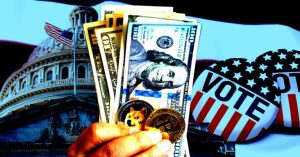Preserving the Power of the U.S. Dollar: A New Bipartisan Bill on Stablecoin Regulation

In a significant move to preserve the dominance of the U.S. dollar, U.S. Senators have introduced a bipartisan bill aimed at regulating stablecoins. This legislative effort underscores the importance of maintaining the U.S. dollar’s leading position in the global economy, especially in the face of rapidly evolving digital currencies.
The Essence of the Bipartisan Stablecoin Bill
What are Stablecoins?
Before delving deeper, it’s crucial to understand what stablecoins are. Stablecoins are a type of cryptocurrency designed to maintain a stable value by being pegged to a reserve asset, such as the U.S. dollar or gold.
Purpose of the New Legislation
Enhancing Financial Stability
The main goal of the proposed bill is to enhance financial stability by ensuring that stablecoins are backed by ample reserves, thus preventing potential market disruptions.
Preventing Misuse
Regulating stablecoins also aims to prevent their misuse for illicit activities, ensuring a safer financial environment.
Implications for the U.S. Dollar and Global Finance
Maintaining Dollar Dominance
By regulating stablecoins, the bill seeks to reinforce the U.S. dollar’s role as the primary reserve currency in the digital age, ensuring its continued influence in international trade and finance.
Impact on Global Financial Systems
This regulation could also shape how global financial systems integrate digital currencies, potentially setting a standard for other countries.
Political and Economic Context
Bipartisan Support and Implications
The bipartisan nature of the bill highlights the unified approach in addressing the challenges posed by digital currencies, reflecting the critical nature of the issue across party lines.
Economic Considerations
Understanding the economic implications of this bill is essential, as it could influence everything from international trade agreements to domestic economic policies.
Comparative Analysis with Other Nations
Global Trends in Crypto Regulation
A comparison with how other nations are handling cryptocurrency and stablecoin regulation can provide a broader perspective on the U.S. approach.
Lessons and Models from Abroad
Learning from the successes and failures of other countries in crypto regulation could help refine the U.S. strategy.
The Future of Digital Currencies in the U.S.
Innovation vs. Regulation
Balancing innovation in the fintech sector with necessary regulations is key to fostering a healthy, competitive market that also protects consumers.
Predictions for the Stablecoin Market
With this new regulation, the stablecoin market is likely to evolve, possibly becoming more integrated into mainstream financial systems.
Challenges and Opportunities Ahead
Navigating Compliance and Innovation
The main challenge will be navigating the fine line between compliance and stifling innovation, which is crucial for maintaining a dynamic financial market.
Potential for Growth in the Fintech Sector
This regulatory move opens up opportunities for growth in the fintech sector by providing clearer rules that could attract more stable investments.
Conclusion
The bipartisan bill to regulate stablecoins is a pivotal development in the ongoing integration of digital currencies into the U.S. financial system. By aiming to preserve the dominance of the U.S. dollar, this legislation not only addresses immediate financial stability concerns but also sets the stage for the future of U.S. and global finance in the digital age.
FAQs
- What is a stablecoin?
- A stablecoin is a type of cryptocurrency designed to have a stable value by being pegged to a reserve asset like the U.S. dollar.
- Why is the U.S. regulating stablecoins?
- To enhance financial stability, maintain the U.S. dollar’s dominance, and prevent the misuse of digital currencies.
- What does the bipartisan nature of the bill signify?
- It shows significant political support across party lines, emphasizing the importance of the issue.
- How might this bill affect global financial systems?
- It could influence global standards for integrating digital currencies into financial systems, potentially reinforcing the U.S. dollar’s role internationally.
- What are the challenges and opportunities presented by this bill?
- The challenge is balancing regulation with innovation, while the opportunity lies in fostering a more stable and secure fintech environment.





